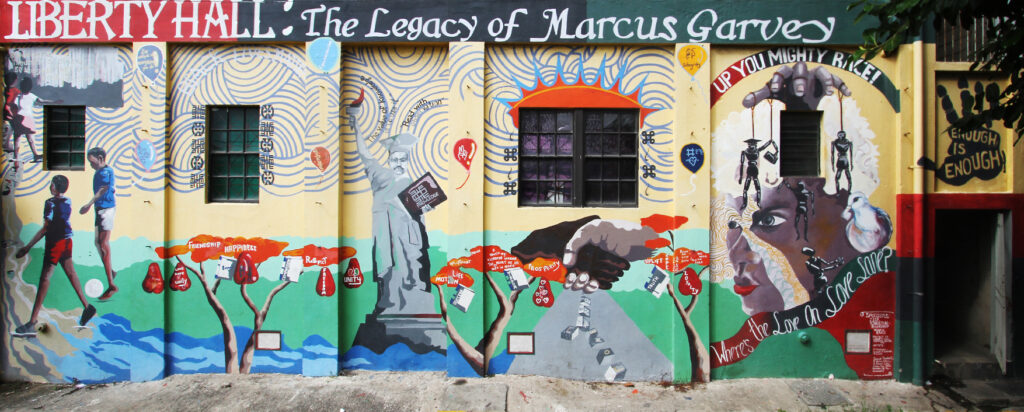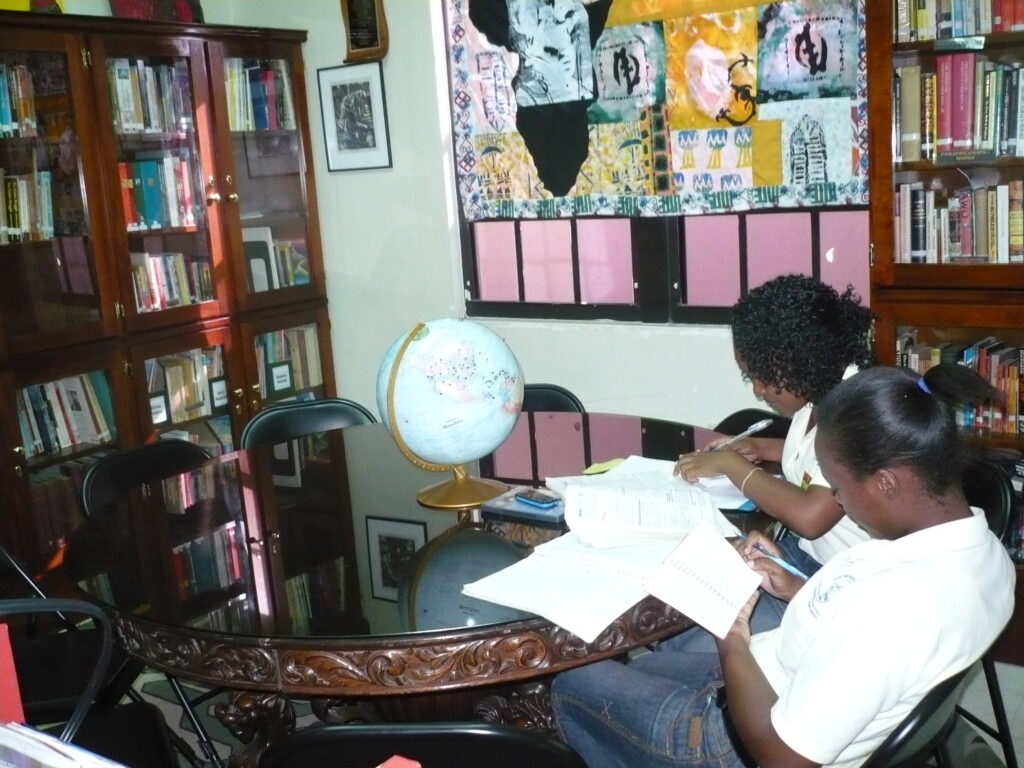A MUSEUM AND SO MUCH MORE: LIBERTY HALL – THE LEGACY OF MARCUS GARVEY

The Marcus Mosiah Garvey Multimedia Museum (MMGMM) is located at 76 King Street in the heart of downtown Kingston. Featuring one of the earliest multimedia exhibits in the region, it is also noteworthy for its focus, mission, and history. Looking back, Professor Emerita and columnist Carolyn Cooper notes that “the story of the museum is a parable of what can be accomplished by far-sighted activists working together.” (Sunday Gleaner, February 11, 2018; A9) Here is just a bit of that story.
It begins in 1923 with the establishment of the headquarters of the Kingston Division of Marcus Garvey’s United Negro Improvement Association (UNIA). This “Liberty Hall” housed a canteen, laundromat, job placement service, and co-operative bank, and was a venue for meetings, lectures, debates, concerts, and dances. All this activity was a manifestation of Garvey’s philosophy of the necessity for Black people to “emancipate [themselves] from mental slavery.” Over time, the building fell into disuse but was fortunately acquired by the Jamaica National Heritage Trust in 1987, marking the centenary of Garvey’s birth.

In 1990, the Friends of Liberty Hall scored approval from the Jamaican Cabinet for an extensive restoration project which was later carried out in collaboration with the Ministry of Education, Youth and Culture, the Jamaican National Heritage Trust, and the Institute of Jamaica. After fifteen years of conquering challenges, the facility was reopened to the public as Liberty Hall: The Legacy of Marcus Garvey. Today it is once again a multi-purpose facility housing the multimedia museum and its gift shop, along with a multimedia/computer centre, reference library, and the Garvey Great Hall – a meeting and performance space on the second floor with a panoramic view of downtown Kingston.
Liberty Hall: The Legacy of Marcus Garvey is an unapologetically Black space that confronts a history of racial stratification through its educational outreach programmes, exhibitions, symposia, and publications. The primary goal is not only to inform the public about the work of Marcus Garvey, Jamaica’s first national hero, but to inspire, excite, and positively affect the self-identity of Jamaican people through a Black-centred approach, informed by Garvey’s philosophy. This mission is at the root of an expanding range of activities.
At the core, the MMGMM holds pride of place on the ground floor at Liberty Hall with a permanent exhibition – Marcus Garvey: the Movement and the Philosophy, which viewers experience through interactive touch-screen technology. Designed by the African-American exhibit specialists known as Art On The Loose, the walls have breathtaking historic images that chronicle the major events in Garvey’s life. Films about Garvey, Black self-identity, and Africa can be viewed in two locations.
Then there is the Garvey Research/Reference Library which houses books, periodicals, and audiovisual materials on Marcus Garvey, the Garvey Movement, Pan-Africanism, and the history and culture of Africa and the African Diaspora. The library also features a children’s collection catering to ages 7 to 17 years.

At a nominal fee, residents of the surrounding inner-city communities can access computers in the Garvey Multimedia Computer Centre where an Adult Computer Literacy Programme is also offered. This space is also home to an After School Programme for children, to help develop literacy, creativity, and library skills along with providing homework assistance. Of course, the pandemic halted this initiative.
In addition to these ongoing programmes, there is an evolving schedule of annual events which has also been interrupted by the pandemic. The annual Summer Arts Programme offered a safe place for children during the school holidays while encouraging them to express themselves through art. Throughout the programme’s years, participating children have produced spectacular works in painting, ceramics, fabric design, and the performing arts.
For older students of secondary and tertiary levels, there is the annual SANKOFA Educational Symposium staged in Black History Month that is presented free of charge to participants. Some of the event’s past themes include Decolonisation in West Africa: Nigeria and Ghana, Apartheid and Post-Apartheid in South Africa, and The 1865 Morant Bay Rebellion. Students have benefited greatly from a deeper understanding of topics on their history syllabi.
In 2010, former Director/Curator Dr. Donna McFarlane, O.D. – whose vision, passion, and commitment guided the institution from 2003 to 2018 – introduced the Annual Marcus Mosiah Garvey Lecture to commemorate the anniversary of the birth of the renowned Pan-Africanist on August 17. Past lecture topics have included Education for Liberation – The Role of Museums (Dr. Donna McFarlane, 2016;, Marcus Garvey and the Fallen Angel (Robert Hill, 2014); Race First and Black Lives Matter (Prof. William H. Boone, 2020); and We Build Forever: The Legacies of Garveyite Women (Natanya Duncan, 2021). The lectures are subsequently published in Liberty Hall’s academic journal 76 King Street.
Research Officer Faith Anderson, who kindly provided information for this article, says, “Our efforts to date have been well received despite the constraints in which we operate. The general feedback is that our endeavours are timely and that they should be held more frequently and be more accessible.” She also outlined some of the “constraints.” At the top of the list is a most familiar challenge – a lack of funding. Liberty Hall: The Legacy of Marcus Garvey is managed and operated by the Ministry of Culture, Gender, Entertainment and Sport and the Institute of Jamaica. One of the celebrated achievements of Dr. McFarlane was that she “successfully sought funding from generous individuals; national and international agencies; the private and public sectors and the philanthropic community for the development and sustainability of Liberty Hall as a cultural/educational institution.” (Cooper, 2018) The published list thanking sponsors on the first anniversary of Liberty Hall’s reopening was truly impressive (see Daily Gleaner, October 19, 2004; 18).
There is also the matter of infrastructure. Limited space in the museum and reference library restricts the number of visitors that can be accommodated and keeps a large part of the collection in storage (a sad truth from a community-engagement standpoint, but likely a more favourable reality for the preservation of collection materials). There is as yet no wheelchair accessibility to the first and second floors, and the Great Hall only seats one hundred individuals comfortably. The computers are now outdated and the internet service is in need of an upgrade in order to facilitate live-streaming of events, an expected element in the (post)pandemic era. Ms. Anderson acknowledges that in this regard as well, funding is a basic requirement for the continued execution of the institution’s mission: “An expansion and/or upgrade of these spaces would better position us to achieve our goals.” It seems the road ahead for the newly appointed Director may not be easy. However, one hopes that once again a community of supporters will rise to the challenge to keep the dream alive and well, enabling the institution to continue empowering its community through its educational offerings and permanent exhibit.
“Up, up, you mighty race! You can accomplish what you will.” — Marcus Garvey
All images courtesy of Liberty Hall: The Legacy of Marcus Garvey
